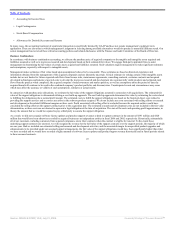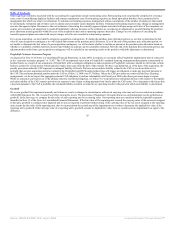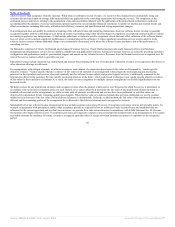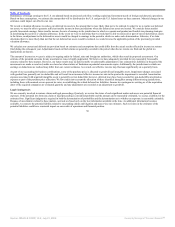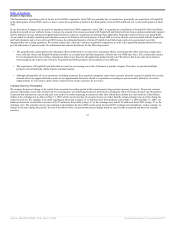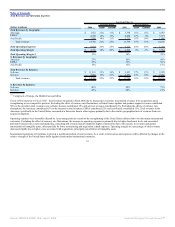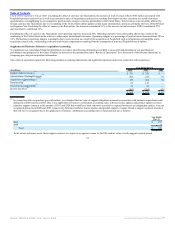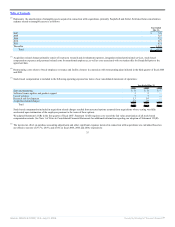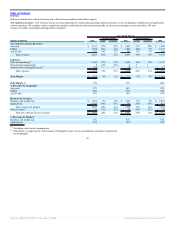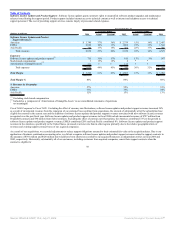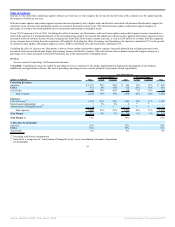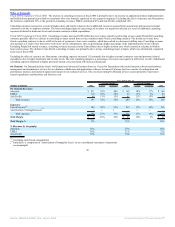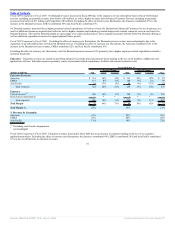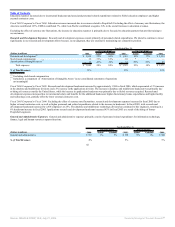Oracle 2005 Annual Report Download - page 35
Download and view the complete annual report
Please find page 35 of the 2005 Oracle annual report below. You can navigate through the pages in the report by either clicking on the pages listed below, or by using the keyword search tool below to find specific information within the annual report.
Table of Contents
Results of Operations
The fluctuations in operating results of Oracle in fiscal 2006 compared to fiscal 2005 are generally due to acquisitions, principally our acquisition of PeopleSoft
in the third quarter of fiscal 2005, and, to a lesser extent, the acquisition of Siebel in the third quarter of fiscal 2006 and Retek, Inc. in the fourth quarter of fiscal
2005.
In our discussion of changes in our results of operations from fiscal 2006 compared to fiscal 2005, we quantify the contribution of PeopleSoft, Siebel and Retek
products to growth in new software license revenues, the amount of revenues associated with PeopleSoft and Siebel software license updates and product support
and On Demand services and present supplemental disclosure related to acquisition accounting where applicable. Although certain revenues were quantifiable,
we are unable to identify consulting and education revenues of Siebel in our fourth quarter of fiscal 2006 as well as allocate costs associated with the PeopleSoft
and Siebel products and services in fiscal 2006 because the substantial majority of former PeopleSoft and Siebel sales and services personnel were fully
integrated into our existing operations. We caution readers that, while pre- and post-acquisition comparisons as well as the quantified amounts themselves may
provide indications of general trends, the information has inherent limitations for the following reasons:
• The quantification cannot address the substantial effects attributable to our sales force integration efforts, in particular the effect of having a single sales
force offer the Oracle and PeopleSoft product families on a neutral basis and the integration of Siebel into our CRM sales force. The commissions earned
by our integrated sales force in these integrations did not vary based on the application product family sold. We believe that if our sales forces had not
been integrated, the relative mix of Oracle, PeopleSoft and Siebel products sold would have been different.
• The acquisitions of PeopleSoft and Siebel did not result in our entering a new line of business or product category. Therefore, we provided multiple
products with substantially similar features and functionality.
• Although substantially all of our customers, including customers from acquired companies, renew their contracts when the contract is eligible for renewal,
amounts shown as support deferred revenue in our supplemental disclosure related to acquisition accounting are not necessarily indicative of revenue
improvements we will achieve upon contract renewal to the extent customers do not renew.
Constant Currency Presentation
We compare the percent change in the results from one period to another period in this annual report using constant currency disclosure. We present constant
currency information to provide a framework for assessing how our underlying businesses performed excluding the effect of foreign currency rate fluctuations.
To present this information, current and prior year results for entities reporting in currencies other than United States dollars are converted into United States
dollars at the exchange rate in effect on May 31, 2005, which was the last day of our prior fiscal year, rather than the actual exchange rates in effect during the
respective periods. For example, if an entity reporting in Euros had revenues of 1.0 million Euros from products sold on May 31, 2006 and May 31, 2005, our
financial statements would reflect revenues of $1.27 million in fiscal 2006 (using 1.27 as the exchange rate) and $1.25 million in fiscal 2005 (using 1.25 as the
exchange rate). The constant currency presentation would translate the fiscal 2006 results using the fiscal 2005 exchange rate and indicate, in this example, no
change in revenues during the periods. In each of the tables below, we present the percent change based on actual results as reported and based on constant
currency.
32
Source: ORACLE CORP, 10-K, July 21, 2006 Powered by Morningstar® Document Research℠





